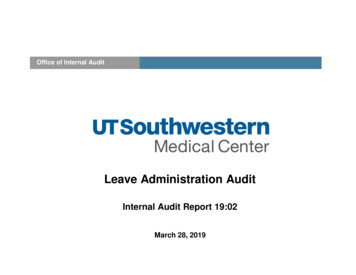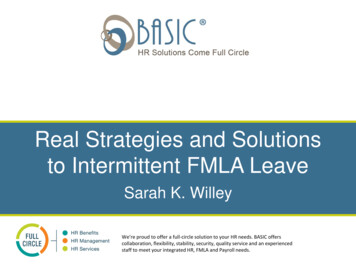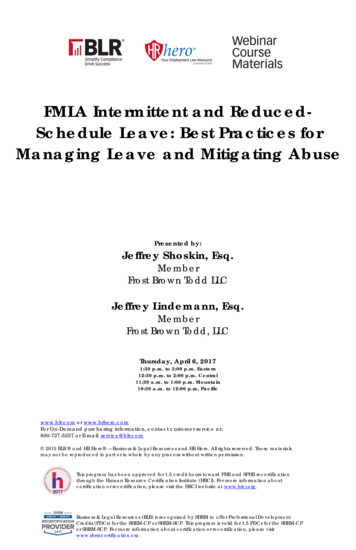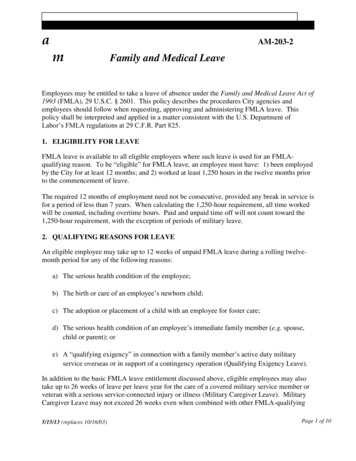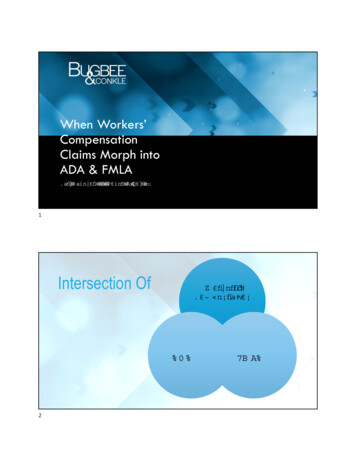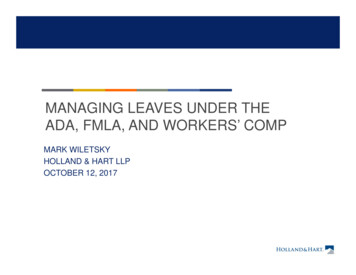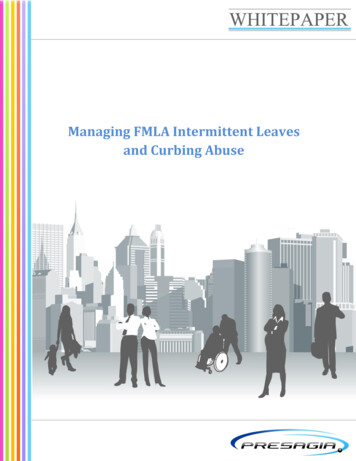
Transcription
Managing FMLA Intermittent Leavesand Curbing AbusePage 1 of 13
TABLE OF CONTENTSIntroduction . 3Understanding the Law . 4Employer Rights . 4Case Study – The Ajax Perfume Company . 7#1 – Harold Underdown, California . 8#2 – Mary Lots, Kentucky . 8#3 – Jean Levis, Alaska. 9#4 – Justin Kerrigan, New Hampshire . 10#5 – Sheryl Newson, Illinois . 11Making Technology Work for You . 11The information in this whitepaper has been derived from a joint presentation entitled “Intermittent Leaves:Managing Difficulties and Curbing Abuse” which was presented at the 2013 DMEC FMLA/ADAAA EmployerCompliance Conference. It was developed and co-presented by Frank Alvarez of Jackson Lewis, Teri Weber ofSpring Consulting Group and Donald Olds of Presagia.NOTICECopyright Presagia 2013. All rights reserved.Presagia is a registered trademark. The Presagia logo is a trademark of Presagia Corp. Other trademarksidentified in this document are the property of their respective owners.Information provided within this guide is not intended to be used as legal guidance. Presagia maintains thatlegal counsel should always be consulted when considering or implementing changes to the leave processesand policies.Page 2 of 13
IntroductionAs the summer months are officially upon us, many employers notice a particular trend that takes placeacross their organization: requests for continuous Family and Medical Leave Act (FMLA) leaves spike alongwith those even trickier intermittent FMLA requests. With long awaited sunny days perfect for afternoonsspent boating, beaching and picnicking, some employees see the use of intermittent leave as the ideal wayto take advantage of the season. Others may wait until hunting season kicks off or see it as a way to extendtheir winter holidays. It’s no secret that managing intermittent leave is one of the most complex areas toadminister under the FMLA and while a surge of employees suddenly requesting intermittent FMLA leavesmay seem suspicious, taking disciplinary action can land employers in hot water. Properly certifying,scheduling and tracking are the basics of the intermittent leave process but knowing how to curb abuse andenforce disciplinary action, when appropriate and required, are equally as important.In this whitepaper we are going to use a case study methodology to show examples of real world challengesthrough a fictitious company, the Ajax Perfume Company. We will also illustrate how to implement theprograms, technology and business processes needed to properly manage intermittent leaves and how touse those programs, technology and business processes to improve intermittent leave management withinyour own organization.When an employee consistently takes FMLA days in what seems like an attempt toextend their weekends and holidays, how do you spot the pattern and curb the abuse?Page 3 of 13
Understanding the LawThe basics of intermittent FMLA leave are the same as regular FMLA continuous leaves. Employers andemployees are subject to certain requirements for eligibility. We’ll explain these briefly below but fordetailed information about eligibility, entitlement and medical certifications download Presagia’s FMLAGuide, Second Edition or Presagia’s FMLA Intermittent Leave Guide.To qualify as an employer you must have 50 employees. To qualify as an employee you must have workedfor your employer for at least 12 months and 1,250 hours in the last year. It should be noted that while theemployee must have worked for you for 12 months, it does nothave to happen consecutively so if an employee is rehiredAn employer and employee can, bywithin a seven year period, all time worked counts towardsagreement, provide intermittent leavetheir FMLA eligibility. Eligible employees may take up to 12for birth and bonding bypassing theweeks of unpaid, job protected leave in any 12 month period“medically necessary” requirementor up to 26 workweeks to care for an injured servicemember.Under FMLA, intermittent leave must be medically necessaryand an employer can require the employee to provide a medical certification. Employers are also entitled toinformation on the expected frequency and duration of the periods of incapacity. Once approved, employeesmay take intermittent FMLA leaves in increments of days, hours and even minutes. Employees may havemultiple intermittent leave cases open at any given time and may take leave without notice in extenuatingcircumstances.Employer RightsWhile many employers are aware of their rights and obligations under the FMLA, they are often reluctant toexercise their rights. Enforcing call-in and call-out procedures, requiring complete and sufficient informationon the medical necessity of intermittent leave and engaging supervisors and managers to properly capture,report and follow up on intermittent leaves all require time and effort. When the process becomes tooonerous, inefficient or unreliable, employers feel less confident in their ability to enforce their policiesaround abuse of intermittent leave. However, while the FMLA may seem like a leave law designed to benefitemployees, employers have their own rights as well and exercising those rights can significantly reduce thecost to an organization for intermittent leave.As an employer you have a right to: Require employees to provide complete and sufficient medical documentation that not onlysupports the leave, but also supports the need for intermittent leavePage 4 of 13
Ask for a second opinion if you receive a medical certification that is suspicious, contains informationthat does not appear to be consistent with the described injury or illness or appears to becontradictoryAsk for a re-certification if the circumstances of the leave have or appear to have changedRequire employees to identify which intermittent leave they are taking an absence for if they havemultiple approved leavesRequire employees to be reasonable when scheduling intermittent leave so as not to cause unduehardship to the operation of the businessAn important piece to ensuring that your employer rights remain protected lies with recognizing that yourrights are not guaranteed but rather conditional. Effective management of intermittent leave requires thatemployers hold employees accountable for fulfilling their legal obligations to give notice, provide supportingmedical documentation and meet the established timelines. However, it is the employer’s responsibility toinform employees in advance of what they must do and say and enforce those obligations. If an employerdoes not educate their employees on these processes, employees have no legal obligations.Let’s use an example to clarify. Under the regulations, an employer is entitled to require that employeesprovide sufficient information for the employer to evaluate whether or not their request for leave qualifiesunder FMLA. If the employer has provided advance notice to the employee of this requirement, and theemployee’s explanation is deemed insufficient, then they have the right to provide written notice of theirdenial of the leave for this reason. However, if the employer had not provided notice of this requirement,they cannot deny the leave for this reason.To summarize, employers may deny intermittent leave requests only if they take action: Before the leave is ever requested;At the time the leave request is made; andAfter employees fail to meet their own obligations.The following table clearly defines some scenarios when employers may lawfully deny an FMLA request aftertaking the appropriate steps.Page 5 of 13
Page 6 of 13
Some employers mistakenly believe that managing FMLA abuse is not worth the effort in their currentmanual process environment because they have difficulty detecting abuse or disciplining with confidencedue to inconsistencies in their own programs. Taking disciplinary action with any uncertainty is a risky moveand one that can land an employer in unwanted and costly litigation. Yet employers who have a handle onmanaging intermittent leave share some straightforward common traits: They educate front line staffThey implement well defined call-in and call-out procedures for all absence and attendanceprogramsThey provide centralized access to absence data for HR and front line staffThey tie participation in wage replacement programs to unpaid leave approvalsThey actively monitor their programsNow let’s move on to the case study to put some of these principles into practice.Case Study – The Ajax Perfume CompanyHeadquartered in Des Moines, Illinois, the Ajax Perfume Company has been in existence since 1926 and hasgrown significantly since its humble beginnings behind the local tannery, where its founder, Pierre Delacroix,of Parisian origin, began to ply his family trade of creating “beautiful scents for beautiful ladies.” Through amixture of organic growth and acquisition, by the end of 2012, Ajax Perfume Company had grown to be thenational leader in perfume confection and distribution, with 4,000 employees employed at five perfumefactories in Illinois, Kentucky, California, New Hampshire and Alaska. As each of the installations beyond theborders of Illinois was acquired, the organization of the Ajax Perfume Company is decentralized, with eachfactory retaining local control of most corporate functions including all aspects of human resourcemanagement. As a result of the acquisitions, the company enjoys a complex web of different Payroll, Timeand Attendance and HRIS systems.M. Delacroix’s grandson, Robert, has recently come into control of the family business and after studyingbusiness, has made the decision to centralize human resource management and ensure that company HRpolicies are harmonized and uniformly applied across all of the company’s installations. His new corporateVP of HR, Lisa “make my” Day, began by inviting all of her HR directors to an off-site meeting and askingthem to bring with them concrete examples of some of the issues that they are having difficulty managing.Five of the cases they brought to the table involved difficulty in managing intermittent leave under theFMLA. These are the cases.Page 7 of 13
#1 – Harold Underdown, CaliforniaHarold Underdown works 10 hour shifts four times per week, Monday to Thursday, operating the mixersthat take the perfume components and blend them to produce the final product. His herniated disk hasresulted in him being absent once a week for three hours to work with his specialized physical therapist. Hissupervisor signed off on his intermittent leave permission form for every Wednesday morning. Whilereviewing his FMLA file, Lisa wonders why he didn’t schedule his appointments for Friday. In his file, she onlyfinds absence slips signed by his supervisor permitting him to be out for FMLA leave yet no accompanyingmedical certification.The California office has failed to establish a proper policy foundation for the management of FMLA. It must: Establish clear and consistent employee-facing policiesTrain managers to understand legal protections available to employeesDevelop a toolbox of forms and letters to facilitate communications with employees in accordancewith legal obligationsLearning PointEmployers forego many of their rights and abilities to manage intermittent FMLA leave if they have notestablished and communicated clear policies that set forth what the employee and employer must dowhen a potential FMLA case exists. In this case the employer should have requested and processed amedical certification and should have deemed it reasonable to ask the employee to reschedule theirappointments for their day off.#2 – Mary Lots, KentuckyMary Lots is New Hampshire’s “Perfumer” and is charged with blending the different scents to invent newproducts to bring to the market. Mary’s nose is in exquisite health, but she suffers from migraines, diabetesand chronic back pain. Given her critical role, Mary’s absence is always noticed and it is being noticed moreand more frequently. One day, the plant manager asked HR to review Mary’s absences for the last two yearsand compare it to the expected frequency and duration of her three approved intermittent leaves. It soonbecame obvious that both the frequency and duration of Mary’s absences accelerated 12 months ago andhad collectively exceeded the combined frequency and duration of her approved leaves. Her leaves werealso often falling on a Friday or Monday. Lisa finds three copies of medical certifications in the file but nocorrespondence prior or any requests for recertification since the cases were opened. She also discovers thatPage 8 of 13
Mary was denied a fourth intermittent leave request but leave as a reasonable accommodation under theAmericans with Disabilities Act (ADA) does not appear to have been considered.While the Kentucky office has effectively communicated to employees their rights and obligations, they lackthe appropriate tools and processes to ensure: Retention of paper and electronic recordsAbsence reasons are captured and assigned to approved leavesNotices to and from employees are being delivered/received on timeHR has the tools to detect differences between expected and actual frequency and durationLeave as a reasonable accommodation under the ADA is consideredLearning PointEven with policies in place, employers must have appropriate systems or resources to detect potentialareas of abuse and prompt actions such as medical recertification. They must also ensure they record allactions and documentation in a centralized case file.#3 – Jean Levis, AlaskaJean Levis, a loader operator in the perfume stock room, did not come to work one day. The next day hecame in with a WH-380-E medical certification form signed by Dr. Zhivago. He mentioned the nature of hisserious medical condition to Lisa in passing. When he left, she reviewed the expected frequency andduration for his intermittent leave reason and even though she had little medical training, it did not seem tocorrespond to the frequency and duration indicated by the doctor. Reflecting that the name Zhivago seemedfamiliar, she went back into her records to look at the last few intermittent leave requests that she had filedfor other employees. Three of them in the last six months were from Dr. Zhivago and all of them hadidentical frequencies and durations prescribed. She realizes that while the office tracks the differencebetween actual and expected frequency and duration, they are missing policies for the review of medicalcertifications and the conditions under which a healthcare provider is asked for clarification.The Alaska office lacks the business processes and workflow to ensure that appropriate information iscaptured and acted on. They need to address: Redesign internal systems and departments administering leave policiesMandate an appropriate review of initial medical certifications and follow up with a review of eachabsence to ensure it matches the certificationPage 9 of 13
Train managers on protocols for escalating complex issues to the leave management teamReport on healthcare provider performanceLearning PointEven with appropriately communicated policies, a comprehensive review of internal processes andworkflow is essential to effectively managing intermittent leave. Look to reporting to identify systemicissues like healthcare providers overprescribing leave or always prescribing the same leave.#4 – Justin Kerrigan, New HampshireJustin Kerrigan is a specialized chemical purchaser working in New Hampshire. He works full time, day shiftand has had an open intermittent leave for four years related to chronic back pain. The New Hampshirebusiness unit had recently taken the decision to outsource leave management to a third party provider. Theleave case manager from the third party provider called Lisa to report that their internal system had flaggedJustin’s intermittent leave file. In the last four years, John had on average missed one day of work per monthexcept for the months of November and December, where he averaged three and a half days per month.Justin’s file contains a complete medical certification and annual recertifications yet knowing that he is ahunting enthusiast, Lisa finds it coincidental that his absences coincide with New Hampshire’s prime deerhunting season – the middle of November to the middle of December – and wonders why his supervisornever questioned his absence patterns over the years.While the New Hampshire office has proper processes for approving and recertifying intermittent leavesthey need to: Train HR to detect differences between expected and actual frequency and durationImplement consistent and equitable processes for approaching suspected abuseEstablish clear guidelines for recertifyingLearning PointA comprehensive review of company policies, procedures and technology will lead to situations whereemployees benefit from all of their rights under the FMLA, while employers ensure that only appropriateleave is granted.Page 10 of 13
#5 – Sheryl Newson, IllinoisWorking as a factory assistant in Illinois, an essential duty of Sheryl Newson’s job is lifting heavy drums,upwards of 50 pounds on a regular basis. During her pregnancy, she was diagnosed with preeclampsia.Shortly after her diagnosis, she applied for intermittent FMLA for scheduled visits to see her healthcareprovider. Her healthcare provider informed her she needed to avoid any heavy lifting so Sheryl was movedto a continuous FMLA leave for the remainder of her pregnancy. As Lisa reviews her file, she notices thatSheryl had the baby over a month ago yet is still on leave with preeclampsia as the reason. She also noticesthat Sheryl was never required to use her accrued paid sick and vacation days, as per company policy. Whileshe has not yet exhausted her FMLA entitlement, Lisa wonders if the manager thinks he is doing her a favorby simply extending her leave not realizing that Sheryl could still be eligible for intermittent leave for birthand bonding without the medical necessity requirement, as long as the employer and employee agree.The Illinois office has the business processes in place for properly certifying intermittent leaves but lacks thetools to maintain compliance throughout the leave. They need to: Clearly communicate company policies regarding employees’ FMLA rights and responsibilities toemployees and managersEnsure that HR is monitoring cases on an ongoing basis, especially once the conditions of the leavehave changedImplement processes to ensure HR is maintaining open, compliant communication with employeesLearning PointCompany policies must be reviewed to ensure that proper policies and processes are in place andmonitored for the entire leave process to ensure that employer rights are respected while avoiding overentitlement or an incorrect leave designation.Making Technology Work for YouEmployers once had two options when managing employee leaves. The first was to use a manual, timeconsuming combination of paper, pencil and spreadsheets. This offered no real possibility of efficientlydocumenting and processing leaves or monitoring individual employees’ and overall organizational absencepatterns. The other option was to hire an outside vendor to take over leave management. While this ‘out ofPage 11 of 13
sight, out of mind’ approach worked for some employers, many found it led to less control over theiremployees, more difficult access to leave information when it was needed, and in the end it did not alleviatethe compliance risk inherent in leave management – if something goes wrong, the employer is often stillliable. Through advances in technology, employers now have the option to manage leave efficiently,effectively and compliantly in-house and can take back control. This allows employers to respond morequickly to their employees’ needs, have a better sense of what is going on in their organization and improvethe leave process on both sides, resulting in both higher employee morale and higher retention rates.As with all leave management, the first step to better control overintermittent leave is accurate, accessible documentation. A goodIt is only through adhering to thesoftware system will record every step in the leave process, fromright process that you canthe time the employee gave initial notice of their need for leaveexercise your contingent rights tothrough to their full return to work. As intermittent leave can becurb intermittent FMLA abuse.very complex and can include a lot of correspondence and manydecisions along the way, you must always be able to go back at anypoint in time to prove you made your best efforts as an employer.While documentation is the first step, the next is to ensure adherence to the timelines set forth by leavelaws. As mentioned earlier, employers have contingent rights when managing the FMLA. To enforce thesecontingent rights, employers must follow the right steps at the right time, sending notices of eligibility,requests for medical certification, reviewing completed medical certifications, sending designation notices,and more. A great software system will automatically notify users with tasks and alerts as these and otherdeadlines approach to support employers’ efforts to enforce their contingent rights and curb intermittentFMLA abuse.In addition to providing process automation to ensure consistent and equitable management, eachstakeholder in the leave process should have access to decision support tools. For instance, leave managerscan benefit from wizards that take them step by step through medical certification reviews and prompt theinput of the information that is needed in order to render a decision. Managers on the other hand need easyaccess to company policies through a tool such as a knowledge base. It is through having all stakeholders inthe leave process educated, from the VP of HR to the front line manager to the employees themselves, thatemployers can ensure the right information and procedures are followed at each step.Looking back at the Ajax Perfume Company case study, monitoring the many aspects of intermittent leavecases is incredibly difficult, especially when employees are in many locations and can have multiple opencases. There is simply not enough time to manually monitor all intermittent cases for absence patterns thatmight suggest potential abuse, entitlement exhaustion and recertification. An invaluable tool that some ofthe latest software systems provide is automatic monitoring of absence patterns and alerts when potentialabuse is identified. Absence patterns could be when an employee takes more days than their approvedPage 12 of 13
frequency and duration or when their days off consistently fall on Monday or Friday or always on a daycontiguous with a holiday. Software should be able to detect this potential abuse and send an alert to thecase manager. The case manager should then have an analysis tool at their fingertips which allows a deeperdive and outlines why the case was flagged, when absences happened, and what the approved frequencyand duration is.Many intermittent leaves are open-ended as they can be in relation to life-long conditions. However, evenfor these cases, it’s important to keep monitoring them, as the extended length can lead to entitlementexhaustion. When this approaches, the case should be flagged and the employee should be sent anexhaustion warning. You also need to be prompted to periodically recertify such cases, in case conditionshave changed. Employers have the right to recertify leaves twice a year, so a best-practice is for the softwareto initiate recertification at the six month mark.When choosing a leave management system, make sure that you implement technology that works for you.Make a list of key questions to ask when evaluating or re-evaluating systems. With the right piece oftechnology added to your leave administration, you will benefit from the confidence that you’re properlyadhering to the provisions of the law, while keeping your organization compliant and respecting youremployees’ rights.For more information about the information provided in this whitepaper or about Presagia, contactinfo@presagia.com or feel free to visit www.presagia.com/enterprise-dashboard for a full list of whitepapersincluding Presagia’s FMLA Guides and Presagia’s FMLA Intermittent Leave Guide, infographics, articles andmore.About PresagiaPresagia provides integrated absence management software solutions to employers and Human ResourcesOutsourcing Providers. These innovative solutions, designed to account for more than 450 pieces of federaland state leave legislation across 53 jurisdictions, enable organizations to increase efficiency, improvecompliance, control absence, and reduce risks and costs. Presagia customers are located around the worldand include enterprises such as Ceridian, CenturyLink/Qwest, American Foods Group and Scripps Health.www.presagia.comPage 13 of 13
may take intermittent FMLA leaves in increments of days, hours and even minutes. Employees may have multiple intermittent leave cases open at any given time and may take leave without notice in extenuating circumstances. Employer Rights While many employers are aware of their rights and obligations under the FMLA, they are often reluctant to
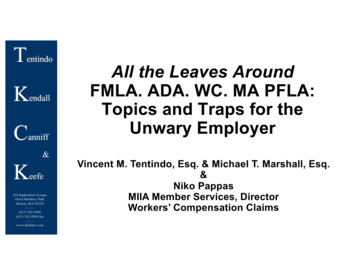
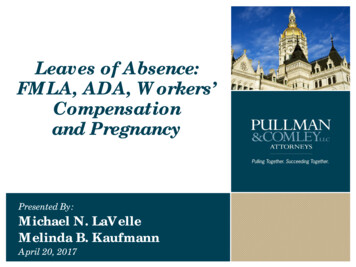
![FMLA Time Types and Leave Code Powerpoint-mw [Read-Only]](/img/56/fmla-time-types-leave-code-110612.jpg)
